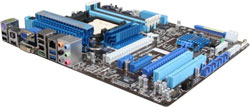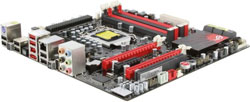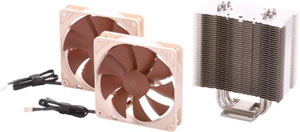Holiday 2010 System Builder's Guide
by AnandTech Staff, edited by Jarred Walton on November 19, 2010 2:00 AM EST- Posted in
- Guides
- Systems
- Holiday 2010
Raja's Midrange Overclocking Systems
What about building a bang-for-the-buck overclocking experience, you ask? As our resident overclocking guru and motherboard reviewer, Raja has more experience with this area than the rest of us so we turned this section over to him. In order to keep things simple, we kept nearly all of the components in Vivek's midrange build but switched out the motherboard, processor, RAM and PSU. We also added an aftermarket cooler to allow the CPUs to reach their full potential. Here's what Raja put together. [Ed: Text by Jarred, most of the picks by Raja.]
| Raja's Midrange AMD Overclocking System | ||
| Hardware | Component | Price |
| Processor |
AMD Phenom II X6 1055T (Thuban 45nm, 2.8 to 3.3 GHz, 6x512KB L2, 6MB L3, 125W |
$179 |
| Motherboard | ASUS M4A89GTD Pro (AMD 890GX AM3) | $135 |
| CPU Cooler | Noctua NH-U12P SE2 120mm SSO | $60 |
| Video | ASUS Radeon HD 6850 1GB (EAH6850) | $200 |
| Memory | G.Skill 2x2GB DDR3-1600 (F3-12800CL9D-4GBNQ) | $65 |
| Hard Drive | WD Caviar Blue 1TB (WD10EALS) | $70 |
| Optical Drive | ASUS 24x DVDRW (DRW-24B1ST) | $20 |
| Power Supply | Seasonic S12II 620W Bronze (80 Plus Bronze) | $75 |
| Case | Antec Nine Hundred Two | $89 |
| Total System Price | $893 | |
For AMD overclocking, I chose one of the hex-core Thuban CPUs, just so you can get every last ounce of performance out of AMD's architecture. The ASUS motherboard ended up being our top AM3 overclocking selection--at least when keeping prices in check--and is good for up to a 50% overclock by raising the base clock. Thuban will  generally top out in the 4.0-4.2GHz range, making this board a perfect fit. The Noctua cooler will help keep things cool without making a ton of noise, and the Seasonic S12II 620W power supply should deliver clean, stable current to the system.
generally top out in the 4.0-4.2GHz range, making this board a perfect fit. The Noctua cooler will help keep things cool without making a ton of noise, and the Seasonic S12II 620W power supply should deliver clean, stable current to the system.
Alternately, if you want to spin the wheel, you can also try your hand at core unlocking and save some money. $100 will buy you the Phenom II X2 560 Black Edition, which has two disabled cores. The ASUS board allows core unlocking, provided your CPU can handle it. Many users have had success with core unlocking, but there's no guarantee, and you'll never get the six cores that Thuban processors offer.
Our memory kit may not look like much, with its DDR3-1600 speed and CAS 9 timings. In reality, it shouldn't limit you but it's getting tricky to determine which memory to buy for overclocking. Vendors are now covering up their IC choices so much it's difficult to know what's inside; what we're looking for is an Elpida BBSE type variant or a similar IC from PSC. The G.Skill kit should work, but YMMV.
| Raja's Midrange Intel Overclocking System | ||
| Hardware | Component | Price |
| Processor |
Intel Core i5-760 Lynnfield 45nm (4x2.8GHz to 3.33GHz Turbo, 8MB L3, 95W) |
$200 |
| Motherboard | ASUS Maximus III GENE (Intel P55 1156) ($20 MIR) | $127 |
| CPU Cooler | Noctua NH-U12P SE2 120mm SSO | $60 |
| Video | ASUS Radeon HD 6850 1GB (EAH6850) | $200 |
| Memory | G.Skill 2x2GB DDR3-1600 (F3-12800CL9D-4GBNQ) | $65 |
| Hard Drive | WD Caviar Blue 1TB (WD10EALS) | $70 |
| Optical Drive | ASUS 24x DVDRW (DRW-24B1ST) | $20 |
| Power Supply | Seasonic S12II 620W Bronze (80 Plus Bronze) | $75 |
| Case | Antec Nine Hundred Two | $89 |
| Total System Price | $906 | |
Okay, first let's get this out of the way: Sandy Bridge is right around the corner. Think your hopped up i5-760 overclock is impressive? Imagine an unlocked Sandy Bridge chip running at 4.3-4.5GHz on air cooling. If you're into Intel overclocking, we'd really consider just waiting a bit longer right now. But, if you must buy a P55 system right now and you want a good overclock....
For the CPU, the i5-760 remains the most sensible choice. Priced at $200, you still get four cores with great overclocking potential--hitting 4.0-4.2GHz is generally common with an appropriate motherboard and cooling. The jump to i7-870 is $80 and all you really get is Hyper-Threading, since maximum  overclocking means you'll want to disable the Turbo Boost feature and most of the Lynnfield CPUs are going to top out around the same 4.2GHz. We might be swayed to make an investment in Core i7 if it weren't for Sandy Bridge; then again, there's an upside: motherboards that used to push nearly $200 have come down quite a bit and there are plenty of rebates going around right now.
overclocking means you'll want to disable the Turbo Boost feature and most of the Lynnfield CPUs are going to top out around the same 4.2GHz. We might be swayed to make an investment in Core i7 if it weren't for Sandy Bridge; then again, there's an upside: motherboards that used to push nearly $200 have come down quite a bit and there are plenty of rebates going around right now.
The motherboard is always a critical component for overclocking, and even though there are plenty of options that can do well, we wanted something more than just a decent overclock. The ASUS Maximus III GENE can easily hit BLCKs far beyond what you'll need for an i5-760, but even better is the excellent voltage regulation that will allow you to push 4GHz and higher without pumping a ton of current through your CPU. ASUS also makes overclocking very easy on the less experienced, with only minor tweaks necessary to get your system running at top speed.
Cooling for both systems comes courtesy of the Noctua NH-U12P SE2, a high quality push-pull cooler capable of keeping your CPU temperatures down without raising noise levels.  While there are decent coolers for a bit less money, we've never been disappointed by the Noctua; it works well even with hex-core processors if you move to X58, so the Lynnfield CPUs aren't going to be a problem.
While there are decent coolers for a bit less money, we've never been disappointed by the Noctua; it works well even with hex-core processors if you move to X58, so the Lynnfield CPUs aren't going to be a problem.
You'll notice that the power supply isn't the OCZ model Vivek used; instead the PSU is a higher quality Seasonic S12II capable of delivering the clean, stable power you'd want in an overclocked system. If you want to move to dual graphics cards and a heavily overclocked CPU, the 620W power supply should still keep up with everything short of the fastest GPUs. If that's what you'd like, I suggest looking at Ryan's X58 high-end SLI build.










112 Comments
View All Comments
Rumpelstiltstein - Friday, November 19, 2010 - link
These are all decent builds for the different price points, but I have a few suggestions for future system guides. Before I say anything else, I would just like to note that I am a big fan of your site, it is always a source of some great journalism and analysis of PC Hardware. Keep up the good work. However, when a PC Hardware site puts up a system guide, I like to use it as a source to send friends to that are thinking of building a new PC and I like to compare between different guides before deciding who to send them to. This is an area that I think you could improve in. I personally think that if you changed your approach to these guides a little bit, it would help out immensely. My model for comparison, since I have found it to be the most comprehensive guide out there is The Tech Report's system guide:http://techreport.com/articles.x/19868
This may or may not be the best example as recently released hardware has changed the game up a lot, but I think some of their guides in the past were pretty spot-on. Anyway, what these guys do is create a few budget tiers and all of the TR Staff debate over the best choice for each part, rather than assigning one person per build. I'm sure this could easily be accomplished by your editors. Sure, it might bring up some heated arguments, but I have no doubt that the final choices will be better overall. I understand that you have more builds here for a wider range of purposes, and that's great, but you can adapt this approach to accomplish the same goal. Even TR often has an alternate build every few months for a different audience. In this last one, they came up with a highly upgradable nettop-like system that is a good recommendation for those who would otherwise go out and purchase a system-in-a-box from the likes of HP or Dell.
Another thing they do is provide links to newegg, since newegg is a good place to determine the price you would likely pay for the overall build and it provides good user feedback for people to look at as well as a great wishlist system for people to plan their purchase with, whether or not they choose to do their final purchases through newegg. This is not as essential a feature, but it does help. Granted, they do have newegg's sponsorship, so they have more incentive to do this. But they have been doing it even before newegg took notice and decided to give their thumbs up.
They also put peripherals, accessories, and extras under a separate topic since these things really are very much user preference and don't necessarily depend on the system they are using them with. And of course, at the end they provide a conclusion to reflect on the changes and how the industry as a whole has changed since their last system guide to lead them to the hardware picks they have chosen for each build.
Again, I'm not suggesting you try to adhere to the formula used by another site, but there are things that can be learned by reading them. I think if you made a few of these changes, particularly the collaboration of all your staff on each build, you will provide a much better guide that more people will be apt to follow rather than just look at, have a chuckle, and do whatever they were gonna do before reading it. You will likely have less members crying "that is a horrible choice for that build, this would be better." Granted that particular person can make all the changes he wants to suit his personal preference, but they could just build their system from the ground up which would render such a guide useless. You might point a few in a better direction with a guide like this, but more knowledgeable people would likely take it with a grain of salt. I think with a better approach you can hit a larger audience with your guides. It's all about helping people make a good investment in their systems and pick good quality parts with a nice price/performance ratio within the limits of a given budget.
Iketh - Saturday, November 20, 2010 - link
Agree 100% with this... when i read the title, and then read who the author was (Anandtech staff), I thought i was gonna read about "the best of now" systems which all the authors collaborated... i was rather disappointed when i saw otherwise :(it IS fun to read about each author's particular taste (and hence get to know them a little better), but you can better demonstrate this if each system is chosen as a team, and then break down, in the explanation, what one author was fighting for in a particular build over another and the ensuing carnage :)... THAT would be fun to read, as well as explaining why eventually one part was chosen over the other
benrico - Friday, November 19, 2010 - link
This is a 32 nm chip... Improperly identified in the mid HTPC build.ERDoc - Friday, November 19, 2010 - link
The one system I'm waiting to build is a large NAS. Something with 20 drives, RAID 6, Blu-ray disc player for backing up my content and serving to multiple HTPCs. WHS Vail or Server 2008 would likely be the OS of choice. 2 x SSD RAID 0 as system drives. Now that 3TB drives are available (soon), are there any server boards will support SATA 6Gb/s, 3 TB drives? I was thinking a Norco 4220 as the case. Any other suggestions? Same for for processors (will be transcoding on the fly, 8 to 10 separate output streams True HD)?Dual GB ethernet at minimum. There are companies such as Vidabox selling systems like this for $10k to $15k. I think I could build a better system (with 2 TB drives) for less
Any other suggestions?
hglazm - Friday, November 19, 2010 - link
No. Stop right here. Do not, DO NOT do these. They are never unbiased, they are rarely good to suit users needs, they direct a tremendous amount of consumers to products they dont need or are too underpowered for, and they will end up degrading you into the likes of TomsHardware.Just stay the fuck away from these, guys. Don't do it.
hglazm - Friday, November 19, 2010 - link
Also, what the hell is up with recommend the Antec BP series?Stuffs a load of crap.
JarredWalton - Friday, November 19, 2010 - link
What are you talking about? This was a Holiday Buyer's Guide and we figured it would be nice to give everyone a voice for a change of pace. This is not intended to be the way we do buyers' guides going forwards, but instead is a large article that covers a huge swath of possibilities in time for Black Friday.As for the BP550, can you point me to any good review that shows it's a "load of crap"? The word on the street is that it's a decent Delta-built power supply. Is it the best PSU out there? No, but if you can pick it up for $35 with the current $30 combo at Newegg with the Antec Three Hundred case, it's a heck of a lot better than most other $35 PSUs. Best info I can find suggests there's nothing wrong with the BP550 (unless you're anti-Antec I suppose).
Bad_Wolf_Online - Friday, November 19, 2010 - link
I have a dual x5680 system, Brian asked for pictures and benchmarks how do I contact him?http://dl.dropbox.com/u/4974831/Cinebench_R11.5%28...
http://dl.dropbox.com/u/4974831/Windows_Task_Manag...
Ryan Smith - Saturday, November 20, 2010 - link
brian@ you know the rest.Hrel - Friday, November 19, 2010 - link
I think this is the best bang for you buck, period.https://secure.newegg.com/WishList/MySavedWishDeta...